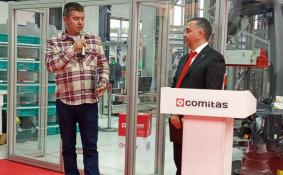Scientific & Practical Journal


Editorial News
Dear readers! We are pleased to present to you the eleventh issue of the journal in 2025. There are a lot of relevant and useful materials in the issue, which, hopefully, will not be ignored.
Dear readers! In September the CeMAT RUSSIA exhibition was held, which showed everyone that innovations and robotics are increasingly penetrating the logistics industry. We can safely say that many technologies are tested here, and only then they go out into the world. However, it is not only CeMAT RUSSIA that demonstrates the prevalence of the digital agenda.
Dear readers! This is the ninth issue of the journal, which turned out to be very rich and diverse. Traditionally, the issue is opened by an analyst. The material by Alina Nasyrova from the Market Guide Agency, dedicated to investments in warehouse complexes in Russia, recalls the importance of developing logistics infrastructure for the integrated development of regions.
PHOTO OF THE WEEK
CITATIONS
Heading:PROBLEMS AND OPINIONS
Mobility of supplies
Oleg Dunaev12 / 2021 | PROBLEMS AND OPINIONS
Annotation. Modern challenges faced by companies in the context of the Covid-19 pandemic, Industry 4.0, environmental constraints and sustainable development (ESG) actualize the demand for mobility of services for the promotion and delivery of commodity, information and financial flows. Mobility has become an important characteristic of the quality of delivery / transportation services in the modern world, the development of which is associated with mobile Internet access technologies.
Formation of a vehicle operation strategy in transport logistics
Sergey Gusev, Igor Kuverin11 / 2021 | PROBLEMS AND OPINIONS
Annotation. The paper deals with modern technologies of managing the efficient operation of rolling stock on motor transport by means of rational models of choosing the strategies of its functioning. The paper reveals the problems of availability of criteria for the system of evaluation and choice of service models for the owners of vehicles.
Assessment of factors affecting export transportation of agricultural products, the delivery of artificially dried grass fodder (alfalfa) being the case
Evgeny Ponomarev10 / 2021 | PROBLEMS AND OPINIONS
Annotation. In the present article were considered the features of export transportation of agricultural products from Russia, which affect the cost, timing and technical capabilities of transportation, using the example of delivering a specific product to some countries. Calculations are made, recommendations are given and relevant conclusions are formulated.
Key words. Transportation of agricultural products, export supply chain for the delivery of products, terms of production of permits for agricultural documents.
On flows in logistics service systems: the plane of integrated logistics
Tatyana Skorobogatova, Margarita Vakhovskaya7 / 2021 | PROBLEMS AND OPINIONS
Annotation. The article identifies global problems of integrated logistics, the communication flows, which perform as the framework of the logistics system, are characterized. The coupling of forward and reverse flows in the logistic production system is shown. Flows of consumers of services as the rod flows in logistic service system are investigated, and attention is focused on outgoing flows. The service is considered in the aspect of flowing processes.
On the definition of the state logistics system
Tatyana Skorobogatova, Margarita Vakhovskaya6 / 2021 | PROBLEMS AND OPINIONS
Annotation. The article lists the main properties of the system, indicates the need to add such properties as the presence of a control element (subject) and purposefulness. The author's definitions of the logistics system in general and the state logistics system in particular are given. It is clarified that the state acts as the managing entity of the state logistics system.
Key words. System, system properties, managing entity, logistics system, state logistics system.
Problems of digital transformation of logistics systems and supply chains
Ivan Ermakov, Pavel Gureev, Valentin Grishin, Oksana Konovalova6 / 2021 | PROBLEMS AND OPINIONS
Annotation. The article considers the main stages of digitalization of economic processes, systematizes the stereotypes of the concept of «digital economy». Based on the analysis, new business practices are systematized. The factors that determine the complexity of digital transformation in logistics systems at all levels are identified. The task of process integration of information systems of logistics companies is formulated. The conclusion is made about the prospects of using process-oriented integration of information systems in logistics.
Assessment of the goods movement delay along the transport corridors of the national logistics system
Vera Vodianova, Nikolai Zaichkin, Ivan Ermakov, Svetlana Kuzminykh3 / 2021 | PROBLEMS AND OPINIONS
Annotation. The article offers a mathematical model of cargo movement along the selected section of the national logistics system, which shows how to calculate the damage caused by the impact of adverse events in the process of cargo transportation on a specific section of the chain. The model estimates the amount of cargo delay when moving along the selected route. Based on this, the damage can be calculated as a function of the value of delay in transit, and decisions can also be made to change the terms of contracts and conditions of transportation organization.
Methodological approaches to the decomposition of the logistics system of a manufacturing enterprise
Grigory Levkin, Natalia Kurshakova, Roman Simak, Rashit Sattarov1 / 2021 | PROBLEMS AND OPINIONS
Annotation. The article discusses the main approaches and the sequence of actions in the decomposition of the structure and functions of the logistics system of a manufacturing enterprise. The features of the logistics problems of the enterprise and the proposed ways of their solution using the principles of logistics are determined.
Key words. Logistic system, analysis, synthesis, logistic function, logistic operation.
Identification activities in logistics as a factor of sustainable development of the transport sector
Olga Zueva, Vladimir Nabokov, Konstantin Nekrasov12 / 2020 | PROBLEMS AND OPINIONS
Annotation. The analysis of the significance of identification activities in the logistics system of goods movement for the sustainable development of the transport sector in the new economic conditions associated with global trends and regional features. Data on the use of identification systems for photo and video recording of traffic violations, ground passenger transport management, automated traffic management, traffic safety, road safety and diagnostics, and incident management are presented.
On the approach to solving the problems to optimize the infrastructure of the region
Pavel Popov11 / 2020 | PROBLEMS AND OPINIONS
Annotation. The article proposes an approach to solving the problem of optimizing the regional logistics infrastructure. The proposed algorithm, considered for the particular case of the problem with single-product flows and two types of vehicles, can also be used for a multi-product model, with various types of heavy and light transport.
Key words. Infrastructure, a network of car fleets, distribution and sub-sorting warehouses, stochastic model, probabilistic demand, two-tier planning, minimum cost flow.











